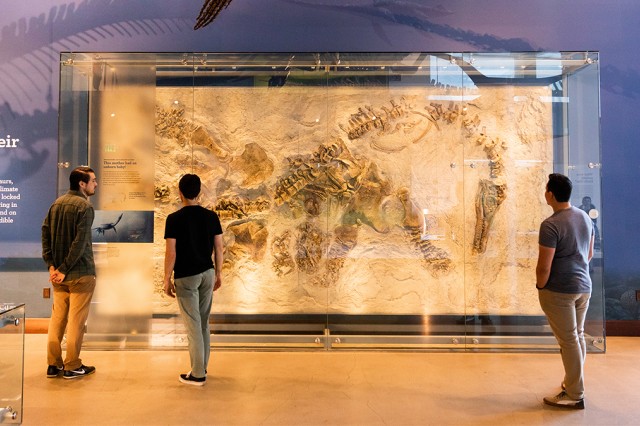Dinosaurs in the Desert
A crew heads to the Badlands of Utah and New Mexico and return with (literally) tons of fossil treasure, plus a few big surprises.

Originally published in the Naturalist magazine in 2015. Photograph (above) by Edgar Chamorro.
A crew of museum paleontologists and international colleagues with the museum’s Dinosaur Institute (DI) headed back to the Badlands of Utah and New Mexico this summer and returned to NHM with literally tons of fossil treasure and a few big surprises. The 20-person team of museum scientists, volunteers, and researchers braved monsoons, grueling hikes, and scorching heat to unearth bones that will help us understand the diversity and evolution of dinosaurs that lived in the Mesozoic period as far back as 150 million years ago.
First stop on the fossil hunt: the desert wilderness of New Mexico. The crew of the Augustyn Dinosaur Expedition 2015 hiked for miles to several dig sites with gallons of water, hundreds of pounds of plaster, and their gear, which included chisels, hammers, drills, and materials to wrap up the bones for transport. Pedro Mocho, a Portuguese graduate student working with the DI, was surveying the landscape for geological clues when he and a colleague spotted an outcropping of bones. There were ribs, parts of a skull, and teeth fragments of a carnivore that hunted nearby 70 million years ago.
“This discovery is likely that of a smaller and older relative of T. rex that was among the top predators of its time,” says DI Director Dr. Luis Chiappe, who oversaw the expeditions. “Carnivore dinosaurs are rare, so this one is a really nice find.”
The New Mexico dinosaur crew also brought back another discovery — backbones of a particularly bulky long-necked dinosaur that lived some 66 million years ago in what is today the American Southwest. It took half a day and four people to haul the 300-pound block containing one of the sauropod’s vertebrae three miles to the nearest road. Caked with sweat and dust, the crew relaxed at their campsite before heading off to a familiar stomping ground in Utah: the Gnatalie quarry.
UTAH’ S HAUL
Museum fossil hunters have been pounding rocks there for many summers since discovering Gnatalie (pronounced “nat-ah-lee”), a Diplodocus-like long-necked dinosaur nicknamed for the stinging gnats that pestered its excavators. Gnatalie’s bones (and those of several other dinosaurs) got buried in what was a riverbed 150 million years ago.
After demolishing a shelf of rock with jackhammers, the crew of the Haaga Dinosaur Expedition 2015 unearthed much of the backbone of (perhaps) another long-necked dinosaur, whose bones are still largely covered by concrete-like rock.
Erika Durazo, who works in the Museum’s Dino Lab, says that there was so much sandstone piled up over the bones that “It looked like we were building a pool!” Years of hard work at the Gnatalie quarry have produced the skeletons of a variety of dinosaurs, including at least six sauropods, some representing species new to science.
NHM’s field expeditions have also yielded specimens that leave visitors to the Dinosaur Hall transfixed: More than a decade ago, Chiappe and his team labored in the Montana Badlands to bring back the 34-foot-tall young adult T. rex. The expeditions produce important scientific discoveries while supporting research and in-the-field experiences for volunteers and a host of visitors. “Expeditions create excitement because you go to uncharted land,” says Chiappe. “And you never know exactly what you’ll find.”
JOIN THE EXCAVATION!
Watch videos of museum excavators digging for fossils in the Badlands at YOUTUBE/nhmla.
